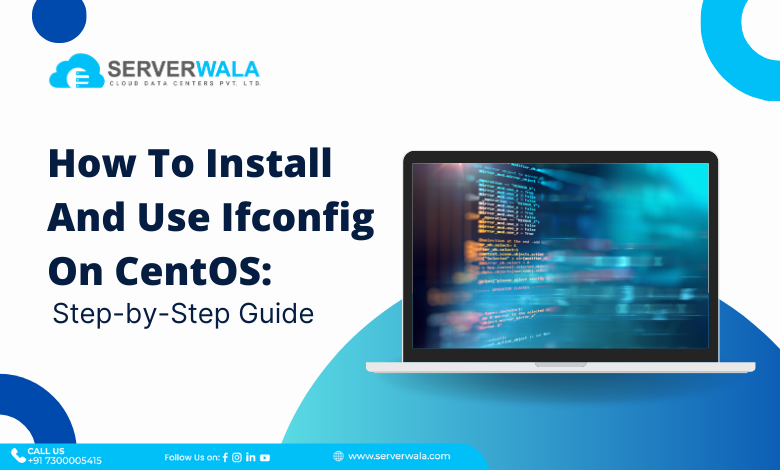How To Install And Use Ifconfig On CentOS: Step-by-Step Guide

Introduction
The interface configuration, or Ifconfig, as many call it, is a tool used in the command line. Now you might question what exactly is a command line. Well, it is an easy way to interact with your system, as the system understands a technical language and you are not used to it. This is where a command line comes out as a savior and translator. We will talk about CLI in detail in our further section, but first, our hero of this article is the interface configuration tool.
This article will guide you on how to use ifconfig on CentOS. We will give you every detail regarding the installation and usage of ifconfig on CentOS. This article will take you through every minute step to complete the process to give you the best result. Don’t worry if you think this will be technical because it is not. Find out more about such insightful things by reading the entire article.
How to Install ifconfig Command?
Let’s talk some more details about this amazing tool before checking out how to install ifconfig. This interface network tool is like a tunnel through which servers are connected and data travels. Let’s imagine an even more simple example, wherein your friend Jack wants to get some books of yours, and the books are placed in your bedroom.
Do you think he can get a hold of them? Obviously, he has to come to your home, and that can be possible only through the main door of your house. At this point, you can relate the main door with the interface network through which your friend Jack can make an entry. In a very similar way, this interface allows other users to reach specific data sets. Now, let’s check how to deploy this fantastic doorway or interface network.
- Update Package Lists: The most important and foremost step is to update the package list to get hold of the latest version of each software. Just use the command “sudo yum update.”
- Install the Net-tools Package: To get your hands on ifconfig tool, you need to install the “net-tools package” first. Simply use the command “sudo yum install net-tools” to ensure proper
Use of ifconfig on CentOS
- Verify Installation: Many times, we tend to forget to recheck the parts for proper installation. Don’t make this mistake, and recheck the installation of ifconfig. The command “ifconfig” will help you do so.
That’s it. Once you get all the details regarding the desired interface network, get ready to check out the next section to learn about the usage process.
Steps to Use the ifconfig Command
At this point, we assume that the interface tool has been installed properly and you are ready to learn how to use it. Follow each pointer below as it is for best results and efficiently use ifconfig on CentOS.
Configuration Information for a Network
If you want to check the settings and adjustments of a particular network, then you need to run the command “ifconfig.” Through this command, you will get the information regarding IP addresses and DNS servers.
Disabling or Enabling a Network Interface
Remember the main doorway through which your hypothetical friend, Jack, came into your home? Sometimes you might want to close that door to temporarily disable the availability. The command “sudo ifconfig [interface] down” will help you with disabling the interface. If you want to enable the interface, simply replace “down” with “up” in the above-mentioned command.
IP Address, Netmask, and Broadcast Allocation
As we have already mentioned, the interface network is used to establish communication. The IP address, Netmask, and Broadcast allocation are part of that communication process. Use the following command in-order to set the different elements of communication:
"sudo ifconfig [interface] [IP_address]" for IP address"sudo ifconfig [interface] netmask [netmask]" for Netmask"sudo ifconfig [interface] broadcast [broadcast_address]" for broadcast allocationModify the Network Interface MAC Address:
Each computer has a unique ID, and so does yours. A MAC address is associated with that unique ID. Security concerns often require you to change this unique ID or MAC address. Use the command “sudo ifconfig [interface] hw ether [new_MAC_address]” to complete the action.
The important elements deeply explain the use of ifconfig on CentOS. These elements make up the ifconfig command and let the user perform high-end tasks.
Also Read: Steps to Unzip/Extract tar.gz Files in Linux Using Command Line
Conclusion
Through this insightful article, we’ve explored the installation and usage of the ifconfig command on CentOS, a vital tool for managing network configurations. Starting with a basic understanding of command-line interfaces, we’ve likened the ifconfig command to a gateway through which data travels in a network. Installation involves straightforward steps like updating package lists and installing the net-tools package.
Once installed, we learned how to gather network information, enable/disable interfaces, allocate IP addresses, netmasks, and broadcast addresses, and modify MAC addresses for security purposes. Mastering ifconfig installation empowers users to efficiently handle networking tasks, making it an essential tool in the CentOS user’s arsenal.





